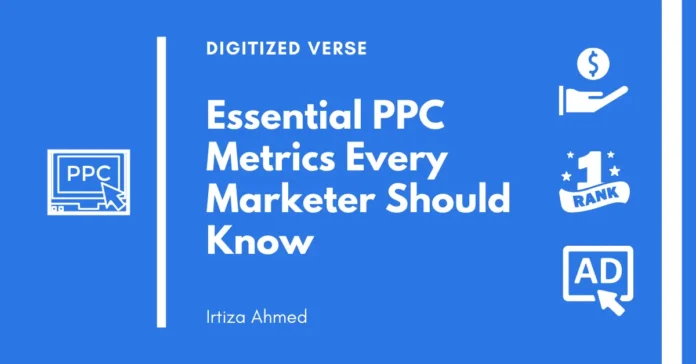Introduction: Why Understanding PPC Metrics Matters
When diving into the world of Pay-Per-Click (PPC) advertising, one of the most important skills you can develop is understanding the key metrics that determine your campaign’s success. These metrics help you gauge performance, optimize for better results, and ensure you’re getting the best return on your investment.
In this blog, we’ll explore some of the essential PPC metrics that every marketer or PPC Analyst should know, along with common misconceptions and real-world examples.
1. Click-Through Rate (CTR): The First Sign of Ad Success
What It Is:
Click-Through Rate (CTR) measures the percentage of people who click on your ad after seeing it. A high CTR indicates that your ad is relevant and engaging to your audience.
How to Calculate:
CTR (Click-Through Rate) = (Clicks ÷ Impressions) × 100
Example:
If your ad receives 1,000 impressions and 100 clicks, your CTR would be 10%.
Misconception:
Many marketers assume that a high CTR is always a sign of a successful campaign. However, a high CTR without corresponding conversions could indicate that your targeting or ad copy needs adjustment.
2. Conversion Rate: Turning Clicks into Actions
What It Is:
Conversion Rate is the percentage of users who take a desired action on your website, such as making a purchase, signing up for a newsletter, or filling out a form.
How to Calculate:
Conversion Rate = (Conversions ÷ Total Clicks) × 100
Example:
If 200 people clicked on your ad and 10 made a purchase, your conversion rate would be 5%.
Misconception:
A low conversion rate isn’t always bad. If the value of each conversion is high, a low conversion rate can still result in a profitable campaign.
3. Conversion Value: Measuring the Worth of Your Conversions
What It Is:
Conversion Value represents the total value generated from conversions. It’s crucial for understanding the financial impact of your campaigns, particularly when paired with other metrics like Cost Per Conversion and ROAS.
How to Calculate:
Conversion Value = Total Revenue from Conversions
Example:
If your campaign led to 50 conversions, each worth $100, your Conversion Value would be $5,000.
Misconception:
Some marketers focus solely on Conversion Rate without considering Conversion Value. A high conversion rate is great, but if the conversion value is low, the overall campaign might not be as successful as it seems.
4. Cost Per Conversion: Measuring Campaign Efficiency
What It Is:
Cost Per Conversion (also known as Cost Per Acquisition, CPA) measures how much you’re spending on advertising to generate one conversion.
How to Calculate:
Cost Per Conversion = Total Ad Spend ÷ Total Conversions
Example:
If you spent $500 on a campaign and received 25 conversions, your Cost Per Conversion would be $20.
Misconception:
A lower Cost Per Conversion is generally better, but it’s important to balance this with the quality of conversions. Paying more for high-quality leads might be more beneficial in the long run.
5. Return on Ad Spend (ROAS): The Bottom Line Metric
What It Is:
Return on Ad Spend (ROAS) is a measure of the revenue generated for every dollar spent on a campaign.
How to Calculate:
ROAS = Conversion Value ÷ Ad Spend
Example:
If you spent $1,000 on ads and generated $5,000 in revenue, your ROAS would be 5:1.
Misconception:
A high ROAS might seem like a clear indicator of success, but if your profit margins are slim, you might still struggle to cover other business expenses.
6. Cost Per Click (CPC): Balancing Bids and Budget
What It Is:
Cost Per Click (CPC) is the amount you pay each time someone clicks on your ad. It’s a critical metric for managing your budget.
How to Calculate:
CPC = Total Ad Spend ÷ Total Clicks
Example:
If you spent $200 on a campaign and received 400 clicks, your CPC would be $0.50.
Misconception:
A lower CPC isn’t always better if it leads to less qualified clicks. Focusing on CPC alone can sometimes result in a waste of ad spend.
Conclusion: The Power of PPC Metrics
By mastering these essential PPC metrics, you’ll be better equipped to analyze your campaigns and make informed decisions that lead to better performance and higher returns. Remember, the goal is not just to understand the numbers but to use them to drive continuous improvement. Once you have a good understanding of essential PPC metrics you can master the advanced ppc metrics.
Looking to dive deeper into PPC analytics? Connect with the best PPC expert to help you master PPC and achieve your marketing goals.




